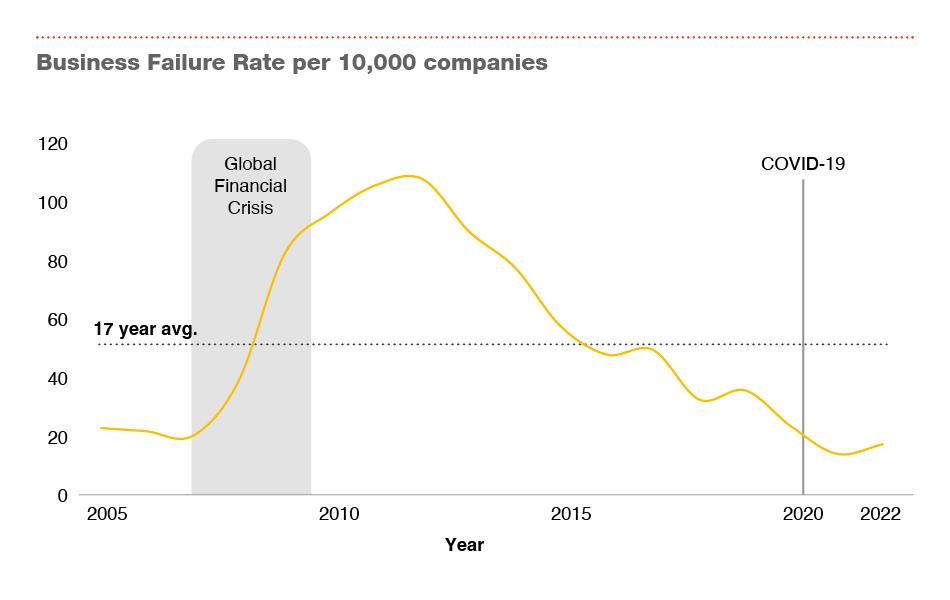Debts of failed businesses expected to reach €2bn in 2022—PwC Insolvency Barometer (Q3 2022)
03 October, 2022
The direct annual economic damage from business failures in Ireland could rise to c. €6 to 7 billion if insolvencies rise to their long term norms.
The number of business failures remains at historically low levels.
On average, just over one company is currently failing every day in Ireland.
Ireland’s current business insolvency rate is running at 17% of the peak rate in 2012.
There is a 31% increase in business failures in Q3 2022 compared to Q2 2022.
There is a 49% increase in business failures in Q3 2022 compared to Q3 2021.
The UK liquidation rate is three times higher than in Ireland.
When looking at county comparisons, Dublin recorded the highest business failure rate with the failure rate increasing by 80% from Q2 2022.

The direct economic damage of business failures in Ireland is expected to be in excess of €2 billion for the year ended 2022. This follows PwC’s new detailed analysis of business failures and their financial impact on Ireland’s economy. For the year to date, over 350 companies have declared insolvency with associated debts outstanding of in excess of €1.6 billion. PwC expects this figure to reach well over €2 billion by the end of 2022. If insolvencies rise to their long term average norms, PwC estimates that the annual direct economic damage of business failures in Ireland could rise to circa €6 - €7 billion.
PwC’s Insolvency Barometer further reveals that the rate of business failures remains at historic and record low levels, but there are signs of an increase in Q3 2022. The business failure rate was 18 per 10,000 companies over the last twelve months to the end of June 2022. This rate is much lower than the average rate over the past 17 years of 53 per 10,000 businesses, with a peak of 109 per 10,000 in 2012.
On average, just over one company is currently failing every day in Ireland. By comparison, in the years following the global financial crisis, over 5 companies a day were failing. This illustrates the record low business failure rate at present but also the potential for business failures to increase if economic conditions worsen.
Quarter-on-quarter growth in business failures was 31% when Q3 2022 is compared to Q2 2022. For example, the number of business failures (5.5 failures per 10,000) in Q3 2022 was marginally higher than the previous quarter (4.2 failures per 10,000). This indicates signs of an increase in insolvencies but from historically low levels.
During Q3 2022, business failures rose by 49% in comparison to Q3 2021. For example, there was a business failure rate of 3.7 per 10,000 in Q3 2021.
The UK liquidation rate is three times higher than in Ireland - recording a liquidation rate of 36 per 10,000 compared to 12 per 10,000 in Ireland for the twelve months ending Q2 2022.
There has been an increase in the Small Company Administrative Rescue Process (SCARP) appointments during Q3 2022 with SCARP appointments accounting for 5% of all insolvencies during the quarter.
Business failures in the arts, entertainment and recreation sectors (21 per 10,000) and in hospitality (15 per 10,000) sectors almost doubled during Q3 2022 when compared to Q2 2022. Of all insolvencies recorded over the last year, 1 in 8 were construction related.
Dublin recorded the highest business failure rate during Q3 2022 (9 per 10,000). This represents a significant increase of 80% when compared to Q2 2022. There were no business failures recorded in 5 counties during Q3 2022 - Roscommon, Cavan, Laois, Waterford and Sligo.
Ken Tyrrell, Business Recovery Partner, said: “Despite energy and other supports in Budget 2023, businesses continue to be faced with a combination of rising inflation, interest rates and energy costs. Inflation and energy costs are immediate issues with interest rates set to become increasingly relevant in 2023 as ECB rates continue to rise. In our view, there will continue to be significant pressure on the profitability and cash flow of many businesses through the winter. The focus should be on performance improvement and cost reduction.”
“As of July 2022, 84,000 businesses were still availing of the Revenue debt warehousing scheme, for a total amount of nearly €3 billion. Discussions with Revenue on restructuring these debts will be hugely important for these businesses over the coming months. Businesses will be carefully assessing whether they can generate enough cash to cover ongoing liabilities in addition to making repayments of historic debts such as parked tax liabilities.”
“Although there were only seven cases recorded, SCARP was utilised in approximately 5% of all insolvencies during Q3 2022. Along with Examinership, it is now one of the primary rescue tools for Irish companies in financial difficulty. SCARP is a viable alternative to liquidation for many SMEs and it is hoped that its utilisation will increase over time.”
Notes to editors
PwC Insolvency Barometer
Business Failure Rate per 10,000 |
Year |
|
Current |
18 |
2022 |
Average |
53 |
N/A |
Highest |
109 |
2012 |
Lowest |
14 |
2021 |
Graph

Over 4,500 businesses saved as a result of Government COVID supports
In PwC’s inaugural report, ‘Act Now: From Recovery to Growth’ published in February 2022, it was estimated that over 4,500 businesses were saved from failure primarily as a result of the Government’s COVID supports, with a number of these businesses essentially being put on ‘life-support’.
Why we use a per 10,000 business measure - Business Failure Rate
PwC’s analysis is based on a per 10,000 measure. It is also widely used when comparing the birth or death rates across different regions or countries. It is a simple yet effective statistic for comparison purposes between different periods, industries, towns, counties or countries with different population sizes. It provides meaningful context to the numbers rather than simply looking at them in absolute terms.
SCARP stands for Small Company Administration Rescue Process. The small company rescue process (“SCARP”) was enacted by the Government to provide an alternative restructuring tool for businesses commencing in December 2021.
About PwC
At PwC, our purpose is to build trust in society and solve important problems. We're a network of firms in 156 countries with over 295,000 people who are committed to delivering quality in assurance, advisory and tax services. Find out more and tell us what matters to you by visiting us at pwc.com.
PwC refers to the PwC network or one or more of its member firms or both, each of which is a separate legal entity. Please see pwc.com/structure for further details.
© 2022 PwC. All rights reserved





